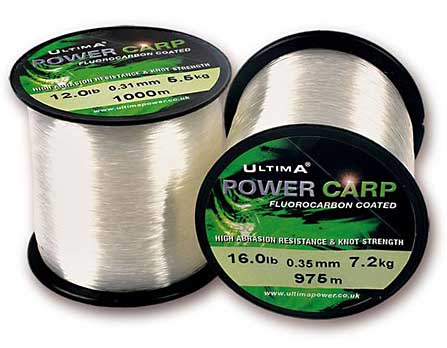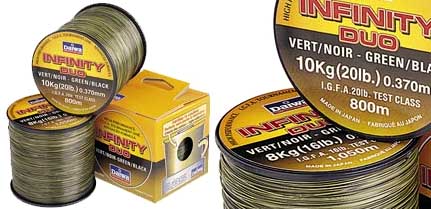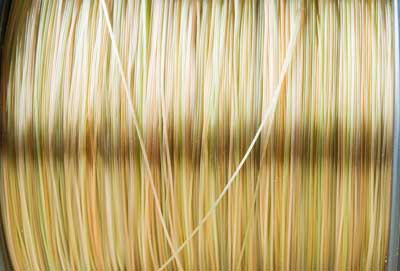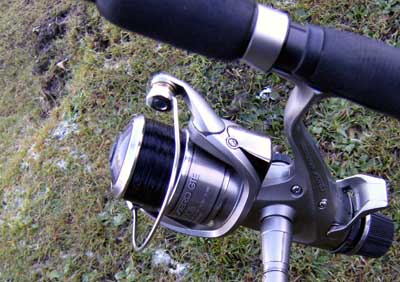Let’s clear up one small point about this series and this article in particular, it’s called “All You Need To Know” and not “All There Is To Know”.
Today, there are perhaps more different manufacturer’s main lines on the market than ever before so it’s no wonder that anglers, especially new ones or people returning to the sport, are confused. Here, I am just dealing with nylon monofilaments or close derivatives, not braid.
Firstly, let’s get a couple of terms out of the way. A new one you’ll see is fluorocarbon and this can be applied to the line in its whole or can mean the line is ‘fluorocarbon coated’.
 These are quality lines and the fluorocarbon part is to give the line a refractive index that is similar to water itself, supposedly rendering it ‘invisible’ below the water. In general, only coated fluorocarbon lines are recommended for main lines with total-fluorocarbon lines being reserved for hooklengths.
These are quality lines and the fluorocarbon part is to give the line a refractive index that is similar to water itself, supposedly rendering it ‘invisible’ below the water. In general, only coated fluorocarbon lines are recommended for main lines with total-fluorocarbon lines being reserved for hooklengths.
Another you will see is ‘copolymer’. These are a more modern development using a different ‘soup’ to make the line, although some are not monofilament in structure. There could be a number of strands welded together to appear as one and they are good in general, but by and large only slightly stronger for their given diameter than the average monofilament nylons lines.
So how do you buy your lines?
Breaking Strain (BS)
This is the more common way of describing and selling the strength of a line and used by just about everyone. However, it’s only half the story because very often, lines will not break at their stated BS and some manufacturers like anglers to boast about this, e.g.: “My 12lbs line will break at 20lbs.”
The reason for this is that often the diameter they have specified for the line is much thicker than is necessary for the BS of that line and probably more in keeping with a line that should be classed as being much stronger. Take our example above and you’ll perhaps find that the said 12lbs line has a diameter (Ø) of .35mm and if you compare it with another manufacturer’s line of .35mm Ø, they could have stamped it with 15lbs BS or even 18lbs, which is perhaps nearer the mark.
So, should you buy on BS or Ø (diameter)? There is no strict guide, really, as all lines will vary and some depend on how much heat as been applied to them in the preparation process. Some were once sold (and still maybe) as being pre-stretched, meaning to reduce the remaining amount of stretch a line has and at the same time, reduce the diameter. What you might expect then is a finer line for a higher strength and with less stretch so that when striking into a fish you make faster contact.
It could all be a load of tosh, but if it sells and gives the user confidence then fine. There is a standard for testing lines and that is EFFTA (the European Fishing Tackle Trade Association), but it costs the manufacturer to submit lines to them and, who knows, they’ll probably mark all similar lines with the same BS to Ø ratios and remove any competitive element within the trade. Here’s what they said about lines they have tested –
11% tested achieved or were better than their stated breaking strength
5% tested had more than 50% less breaking strength than declared
36% tested had between 30% – 50% less breaking strength than declared
26% tested had between 20% – 30% less breaking strength than declared
22% tested had up to 20% less breaking strength than declared
83% of the lines tested had all samples below their stated breaking strength
9% of the lines tested had some of the samples below their stated breaking strength
8% of the lines tested had samples that achieved their stated breaking strength
Doesn’t give you a great deal of confidence, does it?
The answer is to buy line using both the diameter stated with the BS quoted as a guide, in my mind. I have a guide table (in my head) that I use, but I’ll write it here (remember it is ONLY a guide) –
Lines up to .15mm Ø, I class as 2 – 3lbs BS
Lines up to .20mm Ø, I class as 4-5lbs BS
Lines up to .23mm Ø, I class as 5-7lbs BS
Lines up to .25mm Ø, I class as around 8lbs BS
Lines of .28mm or .29mm Ø, I class as 10lbs BS
Line of .30mm Ø as 12lbs
Line of .35mm Ø as 15lbs
Line of .38mm Ø as 18lbs.
So, I may see a nice looking line that states it’s 10lbs at .25mm Ø, but I write on the spool “.25mm – 8lbs” to remind me. I’ve no doubt that if I tested it, it may break at just over 10lbs, but at least I now have that cushion to fall back on.
 Another one you should take care with is Daiwa Infinity Duo (and similar), which is made to IGFA standards. Don’t get me wrong, it is an excellent line, but because it is made to an IGFA test class it has to break within 10% of the lbs stated breaking strain, i.e.: “line designated by the manufacturer as 8 lb class line may test up to 8.81 pounds [4 kg] to qualify for an 8 lb line class record.” otherwise it fails the IGFA test. It’s one of the more honest lines you can buy, but again, I would treat it with a little caution if you want that little bit of a cushion. In other words, if you want an 8lbs line that you can lean into with a bit of confidence, buy the 10lbs and mark it like I do.
Another one you should take care with is Daiwa Infinity Duo (and similar), which is made to IGFA standards. Don’t get me wrong, it is an excellent line, but because it is made to an IGFA test class it has to break within 10% of the lbs stated breaking strain, i.e.: “line designated by the manufacturer as 8 lb class line may test up to 8.81 pounds [4 kg] to qualify for an 8 lb line class record.” otherwise it fails the IGFA test. It’s one of the more honest lines you can buy, but again, I would treat it with a little caution if you want that little bit of a cushion. In other words, if you want an 8lbs line that you can lean into with a bit of confidence, buy the 10lbs and mark it like I do.
|
TIP: keep all your reels and remaining spools of line in the dark when they are not in use to maximise the life of the line. |
Colour
I must have tried them all over the years although one, I’ll mention later, I have only just acquired and have yet to see if it works. It’s my own idea so bear with me. Other than these mentioned I have various shades of greens, browns or greys which seem to be the most popular colours along with clear. Red makes a brief appearance now as they say the colour red is the first to become invisible below 15ft depth of water. Remember that – ‘below 15ft’, if you’re not fishing that deep, fish can see it, can’t they?
Fluorocarbon lines tend to be clear although I’m sure I saw one recently advertised that was a pale green in colour. The clear ones have worked with me, but I have fished two rods side by side at times, fluoro on one and a normal pale green on the other and guess what? Catches on either were about the same. Angler John Bailey once wrote that when he was diving and looking at lines, clear lines could still be seen underwater.
I used to like a Berkley line with a colour described as ‘photochromic’, but when I last bought it some years ago, they appeared to have changed the colour somewhat. It was a strange yellow/coral pink shade, very pale and I liked it was because after it left the rod tip, I couldn’t follow it to the water. I reckoned that if I couldn’t see it in daylight then fish might not see it under water, but that theory probably didn’t hold water anyway.
 I have and still do use ‘camo’ lines, these are space dyed nylons where you will get about 6-8ins of one colour and then 6-8 ins of another and so on using 2-4 colours. The only theory behind these is that they break up the colour patterns as the line lies on the bed of the river/lake. Whether they work or not I don’t know fully, but catches have so far been promising rather than disappointing.
I have and still do use ‘camo’ lines, these are space dyed nylons where you will get about 6-8ins of one colour and then 6-8 ins of another and so on using 2-4 colours. The only theory behind these is that they break up the colour patterns as the line lies on the bed of the river/lake. Whether they work or not I don’t know fully, but catches have so far been promising rather than disappointing.
 As outrageous as it seems I am now using one very fine line in a burgundy colour, well, why not? Maxima, a very popular line, used to be a rich purple sort of colour and people caught enough fish on that. The very latest however (I mentioned earlier) is one I have bought as a camo line only to be used at night – it’s pure black. Ultima F1 is designed as sea line, but I thought that as a lot of my barbel fishing is at night and with no light what better a camo line than a completely black one!
As outrageous as it seems I am now using one very fine line in a burgundy colour, well, why not? Maxima, a very popular line, used to be a rich purple sort of colour and people caught enough fish on that. The very latest however (I mentioned earlier) is one I have bought as a camo line only to be used at night – it’s pure black. Ultima F1 is designed as sea line, but I thought that as a lot of my barbel fishing is at night and with no light what better a camo line than a completely black one!
|
TIP: When you’re loading the line onto your reel, hold it between your thumb and forefinger to keep some tension on it and also feel if there are any blemishes in the line. If there are, discard it and reload afresh. |
Price
Don’t get too wound up on price. Just because you’re buying an expensive line doesn’t mean it’s any better than a relatively cheap one. One of the cheapest lines available must be Daiwa Sensor in clear and brown and it is highly regarded by a lot of very good anglers.
One way to save money is to buy bulk spools, particularly if it is a line you definitely like and want to use for some time to come. A bulk spool may contain anything from 600 metres – 1800 metres depending on make and type, this will last through 6 – 18 spool loads at 100 metres a time so a line costing say £14 for 1200 metres will work out at less than £1.20 per loading. Use your calculator or do some simple math in your head when buying.
Use a low cost very cheap, or even very old, line as backing and only put the barest minimum of good line you’re likely to need to fill the spool. Fill the real’s spool to within 1mm of the lip for best casting.
Finally
Replace nylon (and derivatives) line at least every year and if it’s used a lot or left in daylight, even more regularly. Also replace when it develops a nasty curl (some call it memory) and if this is happening with a brand new line, buy a different brand next time.










